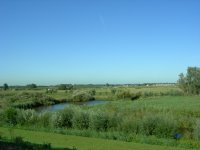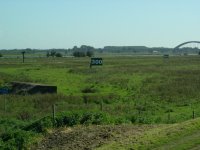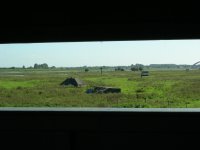Now some pictures from 11 days ago when our brother in law took us by car to some forts of the "Hollandse Waterlinie" near where he and my sister and my parents live. Our first goal was Fort Everdingen. There was a guided tour around the fort of one and a half hour. We couldn't have a look inside the fort, because the fort is still in use by the Ministry of Defense. The Explosives Ordnance Disposal Command of the Royal Netherlands Air Force is using the complex until 2007, so probably after 2007 the fort might be open to the public.
The guided tour was done by the author of a book about the "Hollandse Waterlinie", that was published 4 years ago. Coincidentally I gave Noriko that book two weeks earlier for her birthday. It was an interesting tour, especially because the author of the book told a lot of interesting details. The fort is located at the river Lek. The tour went through the river forelands which contains some nice typical Dutch landscapes.
The guided tour was done by the author of a book about the "Hollandse Waterlinie", that was published 4 years ago. Coincidentally I gave Noriko that book two weeks earlier for her birthday. It was an interesting tour, especially because the author of the book told a lot of interesting details. The fort is located at the river Lek. The tour went through the river forelands which contains some nice typical Dutch landscapes.


 Along the dyke towards the fort you can see bunkers or "group hiding places" as they are called in Dutch.
Along the dyke towards the fort you can see bunkers or "group hiding places" as they are called in Dutch. If you look carefully you can see the signboards which says 300, 600 and 1000 metres. These signboards mark the distance from the fort. Because the forts needed an open line of fire, that's why the building of any obstacles, houses etc.. was regulated by the Prohibited Areas Act ("Kringenwet"). According to this law building within 300 metres was not allowed. Between 300 and 600 metres it was only allowed to built in wood. That's why you still find wooden houses near some forts. Between 600 and 1000 metres you could build in stone, but in times of war or threat of war these buildings could be demolished without any compensation.
If you look carefully you can see the signboards which says 300, 600 and 1000 metres. These signboards mark the distance from the fort. Because the forts needed an open line of fire, that's why the building of any obstacles, houses etc.. was regulated by the Prohibited Areas Act ("Kringenwet"). According to this law building within 300 metres was not allowed. Between 300 and 600 metres it was only allowed to built in wood. That's why you still find wooden houses near some forts. Between 600 and 1000 metres you could build in stone, but in times of war or threat of war these buildings could be demolished without any compensation.  The same view through a concrete military observationpoint. The low bunker is from the First World War and the pyramid shaped bunker was built short before the Second World War.
The same view through a concrete military observationpoint. The low bunker is from the First World War and the pyramid shaped bunker was built short before the Second World War.




No comments:
Post a Comment